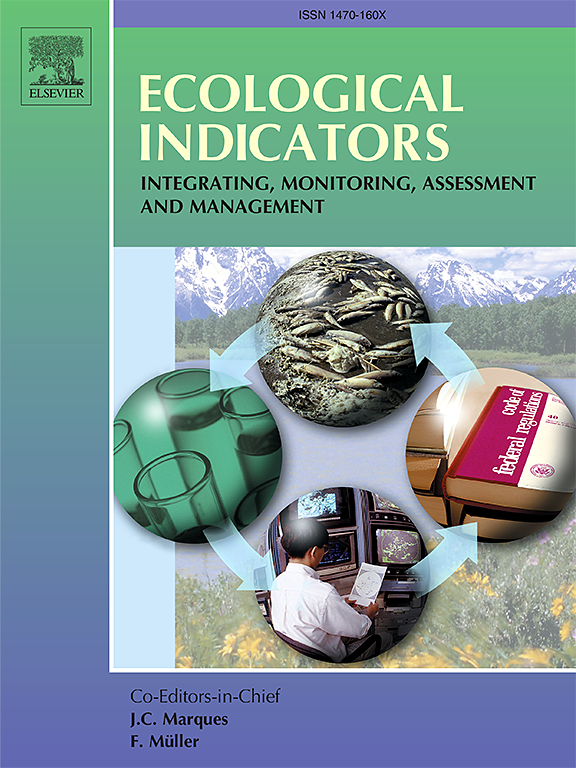海河流域不透水地表扩展形态对生态系统服务和阈值的影响
IF 7
2区 环境科学与生态学
Q1 ENVIRONMENTAL SCIENCES
引用次数: 0
摘要
不透水面面积的迅速扩大对流域生态系统服务功能产生了深远的影响。然而,不透水表面膨胀形态(ISEM)与ES之间的关系仍未得到充分研究。本文以海河流域为研究对象,首次从斑块尺度、形状复杂性和空间聚集度三个维度对ISEM进行量化。利用InVEST模型对生境质量、碳储量、水量和土壤保持进行ES评价,并计算综合生态系统服务(CES)。随后,利用GeoDetector和受限三次样条分析了ISEM对CES的驱动因素、相互作用和阈值效应。最后,进行方差分析,识别不同CES水平区域的ISEM特征,为流域分区和规划提供依据。结果表明:(1)ISEM各指标对CES均有显著影响。在2002 ~ 2022年期间,欧几里得最近邻距离均值(en_mn)对CES的影响最大,其q值分别为0.601、0.586和0.561;(2)除平均形状指数(SHAPE_MN)外,其他ISEM指标与CES呈显著的非线性关系(p <;0.001),其对CES的影响在超过一定阈值后发生变化;(3)高、低CES区域的ISEM分布存在显著差异。本文章由计算机程序翻译,如有差异,请以英文原文为准。

The impact of impervious surface expansion morphology on ecosystem services and thresholds in the Haihe River basin
The rapid expansion of impervious surface areas (ISA) has a profound impact on basin ecosystem services (ES). However, the relationship between impervious surface expansion morphology (ISEM) and ES remains insufficiently studied. This study focused on the Haihe River Basin (HRB) and first quantified ISEM from three dimensions i.e. patch scale, shape complexity, and spatial aggregation. The InVEST model was then employed to assess ES, including habitat quality, carbon storage, water yield, and soil conservation, followed by the calculation of comprehensive ecosystem service (CES). Subsequently, GeoDetector and restricted cubic spline were employed to analyze the drivers, interactions, and threshold effects of ISEM on CES. Finally, an analysis of variance was conducted to identify ISEM profiles for regions with different CES levels, offering a basis for basin zoning and planning. The results indicated that: (1) All ISEM indicators had a significant impact on CES. Notably, during the period from 2002 to 2022, the euclidean nearest-neighbor distance mean (ENN_MN) showed the largest influence on CES, with q-values of 0.601, 0.586, and 0.561, respectively; (2) Except for mean shape index (SHAPE_MN), other ISEM indicators showed significant nonlinear relationships with CES (p < 0.001), with their impact on CES changing after exceeding certain thresholds; and (3) ISEM profiles exhibited contrasting differences between regions with high and low CES.
求助全文
通过发布文献求助,成功后即可免费获取论文全文。
去求助
来源期刊

Ecological Indicators
环境科学-环境科学
CiteScore
11.80
自引率
8.70%
发文量
1163
审稿时长
78 days
期刊介绍:
The ultimate aim of Ecological Indicators is to integrate the monitoring and assessment of ecological and environmental indicators with management practices. The journal provides a forum for the discussion of the applied scientific development and review of traditional indicator approaches as well as for theoretical, modelling and quantitative applications such as index development. Research into the following areas will be published.
• All aspects of ecological and environmental indicators and indices.
• New indicators, and new approaches and methods for indicator development, testing and use.
• Development and modelling of indices, e.g. application of indicator suites across multiple scales and resources.
• Analysis and research of resource, system- and scale-specific indicators.
• Methods for integration of social and other valuation metrics for the production of scientifically rigorous and politically-relevant assessments using indicator-based monitoring and assessment programs.
• How research indicators can be transformed into direct application for management purposes.
• Broader assessment objectives and methods, e.g. biodiversity, biological integrity, and sustainability, through the use of indicators.
• Resource-specific indicators such as landscape, agroecosystems, forests, wetlands, etc.
 求助内容:
求助内容: 应助结果提醒方式:
应助结果提醒方式:


